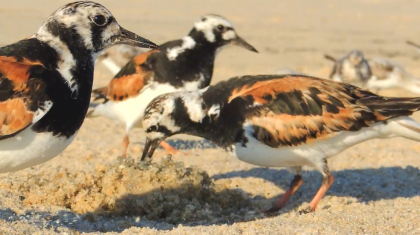
Red knots, ruddy turnstones, sanderlings and other shorebirds are now passing through the Mid-Atlantic on their south bound flights from high latitude nesting grounds.
These species are well known for stopping at the Delaware Bay in spring to eat horseshoe crab eggs, but recent observations suggest that they might be getting some horseshoe crab-derived calories during the fall as well.
Above is a video I took last week on the Delaware Bay of ruddy turnstones and sanderlings gobbling up developing horseshoe crab eggs. The scene is reminiscent of spring time, with birds gathering around an excavated horseshoe crab egg cluster.
A closer examination of the area where the birds were feeding revealed that, indeed there was a high density of egg clusters in the embryo stage. See the video below for a view of one of these clusters.
The story behind these clusters is not entirely clear. Are they from late-spawning horseshoe crabs? Are they developing more slowly than usual?
Typically horseshoe crab eggs are expected to develop into larvae in 30 to 45 days. But this timing varies according to a variety of factors including temperature and salinity.
I resurveyed some of the Delaware Beaches last week and found that for the most part, the remaining egg clusters in the beach are at the larval stage.
This is not surprising because It’s been previously documented that a proportion of horseshoe crab larvae remain under the sand all the way through winter.
The lag in the departure of larvae might be related to their depth in the sand and wave conditions.
Previous research suggest that larvae like to have the help of heavy wave action to liberate them from the sand. Larvae might bide their time under the sand for quite some time before conditions are favorable for departure.
In recent weeks observers have noted that shorebirds are also feeding on horseshoe crab larvae along Delaware Bay beaches.
The spring crop of horseshoe crab eggs are now, for the most part, larvae. Studies have shown that these larvae remain close to the shoreline, and so are available for shorebirds and marine life to feed upon. The larvae have a tendency to be nocturnal, which is probably an anti-predator defense.
While we know very well the resource horseshoe crabs offer to shorebirds in spring, we know less about the ecological role these eggs, larvae and young crabs play in the ecosystem beyond the birds and beyond spring.
All those young crabs in the Bay right now are a big resource and we can pretty sure that birds, fish and other critters are exploiting it if they can.